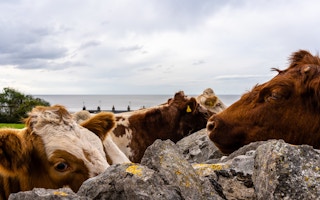Every time a cow burps, it releases a bit of methane, a potent greenhouse gas that traps more heat than carbon-dioxide.
The livestock sector accounts for a significant 14.5 per cent of man-made greenhouse gas emissions and, in the Asia Pacific region, demand for dairy products is growing along with its middle class.
Driven by the growing number of cattle farms, methane emissions are at an all-time high, and could cause a disastrous global temperature rise of three to four degrees Celsius by 2100 if left unchecked, according to a recent Stanford University study.
“Emissions from cattle and other ruminants (herbivorous mammals) are almost as large as those from the fossil fuel industry for methane,” said Rob Jackson, a professor of Earth system science at the university who led the study. “People joke about burping cows without realising how big the source really is.”
With demand for beef and other meats expected to increase in tandem with growing wealth in countries such as China and India, some companies are taking steps to help the animal farming industry reduce its environmental impact.
Global nutrition, health and sustainable living company DSM, one of the world’s leading producers of nutritional ingredients, is testing an animal feed additive for cows that has reduced their methane emissions by about 30 per cent in previous and ongoing trials.
In August, the firm also launched a strategic initiative called “We Make It Possible” to make animal farming sustainable. It takes as its targets the United Nations’ Sustainable Development Goals 2, 3, 12, 13 and 14, which aim for zero hunger, good health and well-being for all, responsible consumption and production, action against climate change, and sustainable use of marine resources respectively by 2030.
Peter Fisher, DSM’s regional vice-president for animal health and nutrition in Asia Pacific, said that while plant-based diets have become more popular, meat still makes up a significant portion of many meals. “We have to figure out how to meet this demand in a responsible and sustainable way, and we have to do this with urgency,” he said.
To feed a world population of 9.7 billion by 2050, scientists have highlighted the need to avoid further deforestation, grow more efficiently on existing farms and shift to less meat-intensive diets, among other measures.
“
We have to figure out how to meet this demand in a responsible and sustainable way, and we have to do this with urgency.
Peter Fisher, regional vice-president for animal health and nutrition in Asia Pacific, DSM
Transforming farming
DSM’s initiative will promote its products and initiatives in six areas: Improving farm animals’ health and yield; improving the quality of food while reducing food waste and loss; cutting livestock emissions; making more efficient use of natural resources; reducing reliance on marine resources; and tackling anti-microbial resistance.
One of DSM’s solutions, a feed additive for cows called Bovaer, is currently undergoing trials in New Zealand and Australia and pending registration for use in Europe. When mixed into a cow’s feed, it inhibits an enzyme in the animal that triggers the production of methane. The additive has already been tested in over 30 farm trials, with over 25 peer-reviewed studies published in science journals attesting to its efficacy and showing no negative effects on the cows’ health or milk.
The company also created Hy-D, a vitamin D additive already on the market that helps pigs and chickens to build stronger skeletons and lead healthier and longer lives. This means that pigs can have more piglets over their lifetime, among other advantages for farmers. Feeding Hy-D to chickens also enables them to lay eggs that have shells that are about four per cent thicker, reducing egg breakages during packing and transport by about 15 per cent.
Each year, about 16 million tonnes of wild oily fish such as anchovies, sprat and capelin are caught and processed into fish meal and fish oil for aquaculture. The oil, in particular, contains two omega-3 fatty acids, eicosapentaenoic acid (EPA) and docosahexaenoic acid (DHA), that are used to grow nutritious fish for human consumption, especially in the salmon industry.
To reduce the reliance on these marine resources, DSM has partnered with another firm, Evonik, to produce EPA and DHA by fermenting natural marine algae. The amount of EPA and DHA in one tonne of the algal oil is equivalent to that in 60 tonnes of the wild-caught fish. DSM said that the partnership can currently meet 15 per cent of the salmon industry’s demand for EPA and DHA, equivalent to saving 1.2 million tonnes of wild-caught fish per year.
Fisher said that the firm will also help farmers make more efficient use of local crops for their animal feeds and other needs. “If they can do that, they won’t have to transport resources from across the world, and this will reduce their environmental footprint,” he explained.
He noted that the world’s growing population and demand for animal protein will continue to put huge and increasing pressure on its finite natural resources. “Along with the strain on the environment, this threatens to take our food systems well beyond the planet’s boundaries,” he said.
“Through our new strategic initiative, we hope to achieve a transformation in animal farming that will not only ensure a decent living for farmers but make animal farming sustainable and foster a brighter future.”






















